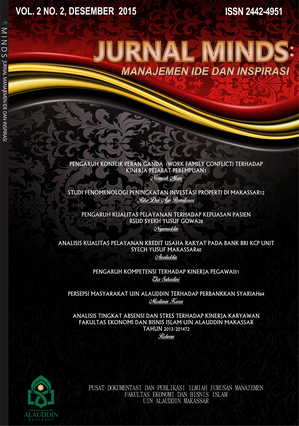Date Log
Copyright (c) 2021 Andi Mattingaragau Tenrigau

This work is licensed under a Creative Commons Attribution 4.0 International License.
“Turun” as Participatory Budgeting Practices based on Siri' Na Pesse at the Death Ceremony in Baebunta, North Luwu Regency, Indonesia
Corresponding Author(s) : Andi Mattingaragau Tenrigau
Jurnal Minds: Manajemen Ide dan Inspirasi,
Vol. 8 No. 1 (2021): June
Abstract
This study aims to determine participatory budgets of siri’ na pesse in “turun” tradition of death events in Baebunta, Luwu Utara Regency. The study uses an interpretive paradigm with a methodological and ethnographic study of siri’ na pesse. The results show that "turun" is as a participation form of to maega (society) in mobilizing a budget based on a sense of pesse (empathy) and siri’ (shame). The budget mobilization process consists of three parts, namely planning, determining sources, and budget allocation. The first part begins with an internal meeting of the bereaved and relative families; secondly, determining the almost-equally-divided source of the budget; thirdly, the budget allocation to finance the funeral procession and the night of takziah (condolence). The ativities properly shows the upright siri’ (self-esteem) for the bereaved family.
Keywords
Download Citation
Endnote/Zotero/Mendeley (RIS)BibTeX
References
Agger, B. (2003). Teori Sosial Kritis: Kritik, Penerapan, dan Implikasinya. Yogyakarta: Kreasi Wacana.
Andaya, L. Y. (2004). Warisan Arung Palakka: Sejarah Sulawesi Selatan Abad Ke-17. Makassar: Ininnawa.
Arif, B., Muchlis, & Iskandar. (2009). Akuntansi Pemerintahan. Jakarta: Akademia.
Cristina, E., Fuad, M., Sugianto, & Sukarno Edy. (2002). Anggaran Perusahaan. Jakarta: PT Gramedia Pustaka Utama.
Garrison, N. & Brewer. (2007). Akuntansi Manajerial. 11th edition. Jakarta: Salemba Empat.
Hamid, A. (2005). Kepercayaan dan Upacara dari Budaya Bugis Kuno, in Nurhayati Rahman, Anil Hukma, dan Idwar Anwar (ed) Laga Ligo: Menelusuri Jejak Warisan Dunia. Makassar, Pusat Studi Laga Ligo Divisi Ilmu Sosial dan Humaniora Pusat Kegiatan Penelitian Unhas.
Lopa, B. (2005). Siri Dalam Masyarakat Mandar. Dalam Siri’ dan Pesse: Harga Diri Bugis, Makassar, Mandar, dan Toraja. 2nd edition. Makassar: Pustaka Refleksi.
Neuman, W. L. (2003). Social Research Methods: Qualitative and Quantitative Approache. Boston: Allyn and Bacon.
Mattulada. (2005). Siri’ dalam masyarakat Makassar. In M.Y. Mustafa, A. Nasyaruddin, & A.W. Tangke, Siri’ dan pesse: harga diri Bugis, Makassar, Mandar, dan Toraja, 2nd Edition. Makassar: Pustaka Refleksi.
Pelras, C. (2006). The Bugis. Translator Abdul Rahman Abu, Hasriadi, dan Nurhadi Sirimorok. Jakarta: Nalar dan Forum Jakarta Paris.
Tenrigau, A. M., Dahlan, H., Uleng, B. P., & Aida, N. (2020). Penganggaran Berbasis Kearifan Lokal: Studi Siri’ Na Pesse Metodologi Pada Program Desa Mengepung Kota Di Kabupaten Luwu Timur. Jurnal Ilmiah Administrasi Publik PKP2A LAN Makassar, 14 (2), 91-98.
Tenrigau, A. M. & Said, D. (2017a). Pesse Na Siri’ Budgetary System: A Historiography Study of Luwu Kingdom in Islamic Period. Journal of Research in Humanities and Social Science, 5 (8), 58-65.
Tenrigau, A. M., Triyuwono, I., Said, D., & Damayanti, R.A. (2017b). Reconstruction of Pesse na Siri’ Budgeting Consept: A Posmodernism Study in East Luwu Regency. International Journal of Science and Research, 6 (5), 216-222.
